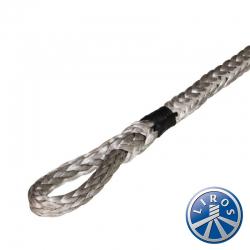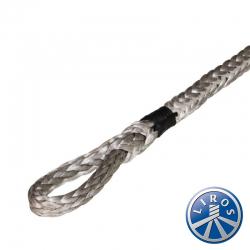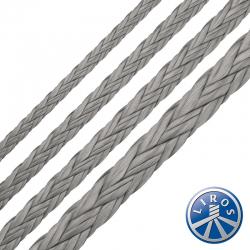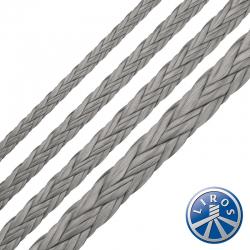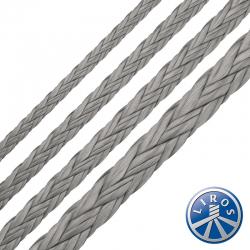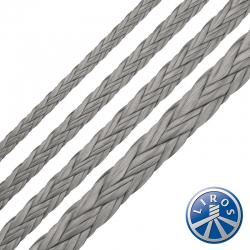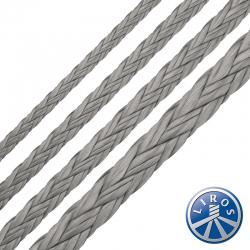Fibre rigging is increasingly popular for multihull standing rigging and other specific yacht rigging applications.
Fibre solutions for monohull shrouds are less common due to the high loads produced by the acute geometrical relation to the mast. Consider the specification very carefully before switching from Stainless Steel Wire to Fibre for Standing Rigging. Consultation with the rope manufacturer or an onsite qualified rigger/surveyor is recommended.
The main benefits of composite, synthetic fibre rigging relate to a significant reduction in weight, a considerable increase in strength and the benefits of positive visual inspection.
The diameter of Dyneema fibre rigging should be specified by two critical criteria:
- The fibre should stretch less than the wire it is replacing
- To eliminate creep, the working load on the fibre should be less than 20% of the rated break load
Consequently, when fibre rigging is specified to ensure zero creep at the expected load, it will be far stronger than the wire it replaces. Correctly stipulated fibre rigging should result in at least a doubled break load, which could be even as great as x5. The extra strength is reassuring because it allows for a certain amount of chafe and UV damage during use without compromising the rig.
The advantage of fibre rigging solutions and their fittings is not only a reduction in weight but also the opportunity for a full visual inspection. Any sign of wear or deterioration will be gradual and visible, which allows for an appropriate maintenance schedule to avoid any risk of failure. The first signs are best described as a fuzziness on the exposed surface of the fibres. The crucial factor is that deterioration occurs on the outside, which starkly contrasts stainless steel wire, where failures can occur from within without any advance warning.
Specifying fibre rigging is a process that should relate directly to the comparative stretch characteristics of the wire it is replacing.
Fibre rigging should not be specified by breaking strain alone, as this will inevitably result in a stretchy rig.
DynIce Dux Weight and Break Load Information Chart including a comparison guide with standard 1x19 stainless steel wire by equivalent creep/stretch
| DynIce Dux Diameter |
DynIce Dux Weight per 100 metres in kg |
DynIce Dux Linear Strength in tons |
DynIce Dux Spliced Strength in tons |
1x19 Stainless Wire equivalent diameter for Creep/Stretch ** |
| 5mm |
2.27 |
4.8 |
4.3 |
n/a |
| 6mm |
3.28 |
6.8 |
6.1 |
5mm |
| 7mm |
3.75 |
7.5 |
6.7 |
6mm |
| 8mm |
4.92 |
9.9 |
8.9 |
n/a |
| 9mm |
5.4 |
10.9 |
9.8 |
n/a |
| 10mm |
6.8 |
13.5 |
12.2 |
7mm |
| 11mm |
8.3 |
16.6 |
14.9 |
8mm |
| 12mm |
9.7 |
18.8 |
16.9 |
n/a |
| 13mm |
11.2 |
22.4 |
20.2 |
10mm |
| 14mm |
13.6 |
27.3 |
24.6 |
n/a |
| 15mm |
14.4 |
28.8 |
25.9 |
12mm |
| 16mm |
18.6 |
37.2 |
33.5 |
14mm |
| 18mm |
22.6 |
45.1 |
40.6 |
15mm |
| 20mm |
27.4 |
54.7 |
49.2 |
16mm |
| 21mm |
32.1 |
64.2 |
57.8 |
19mm |
** 1x19 stainless wire equivalent diameter for creep/stretch information is courtesy of Colligo Marine.
Jimmy Green Marine offers fibre rigging options from Dynice Dux, LIROS and Marlow Ropes, which can be sub divided into two categories:
1. Backstays, Runners and Checkstays
- Marlow D12 Max - the super pre-stretched and heat-set version of standard D12 Dyneema 78.
- LIROS D Pro XTR article 01514 - 100% pure Dyneema® SK99 rope with the latest in coating technology - Manufactured in a 12plait hollowbraid construction which makes it extremely good to handle and easy to splice - LIROS-Heat-Stretch-System - unique LIROS pre-stretching process, calibrated under exacting temperature and tension conditions, designed to minimise stretch and enhance performance - LIROS Coating System - the LCS polyurethane impregnation process improves resistance to abrasion and UV damage by up to 50%.
2. Standing Rigging
- LIROS D Pro Static article 01504 - 12 strand Hollowbraid from specially engineered Dyneema DM20 fibre delivering near zero creep, LIROS Heat Stretch System, LIROS Coating System
- Marlow M Rig Max - 12 strand plaited construction from super pre-stretched Dyneema DM20, near zero creep, Armourcoated
- Hampidjan DynIce Dux - super pre-stretched Dyneema SK75 12-strand construction - although the initial stretch of SK75 is not comparable with other fibres, it is more responsive to heat stretching, which results in near zero creep and constructional bedding in Hampidjan's super-enhanced DUX version.
Jimmy Green Break Load Comparison Guide for 12 strand Dyneema Fibre Rigging for: Hampidjan DynIce Dux, LIROS D Pro Static, LIROS D Pro XTR, Marlow M Rig MAX and Marlow D12 MAX78
| Line |
Hampidjan |
LIROS |
Marlow |
| Diameter |
DynIce Dux |
D Pro Static |
D Pro XTR |
M-Rig MAX |
D12 MAX 78 |
| 2.5mm |
x |
x |
580kg |
839kg |
935kg |
| 3mm |
x |
900kg |
1150kg |
1260kg |
1400kg |
| 4mm |
x |
1230kg |
1500kg |
2070kg |
2300kg |
| 5mm |
4800kg |
2450kg |
3200kg |
2670kg |
2980kg |
| 6mm |
6800kg |
4050kg |
5600kg |
3820kg |
4250kg |
| 7mm |
7500kg |
x |
x |
6270kg |
6980kg |
| 8mm |
9900kg |
5000kg |
7000kg |
7840kg |
8730kg |
| 9mm |
10900kg |
x |
x |
9020kg |
x |
| 10mm |
13500kg |
8500kg |
11000kg |
10500kg |
11700kg |
| 11mm |
16600kg |
x |
x |
12600kg |
x |
| 12mm |
18800kg |
11300kg |
15000kg |
15000kg |
16700kg |
| 13mm |
22400kg |
x |
x |
17700kg |
19700kg |
| 14mm |
27300kg |
x |
17000kg |
x |
x |
| 15mm |
28800kg |
x |
x |
22100kg |
24600kg |
| 16mm |
37200kg |
x |
22400kg |
x |
x |
| 17mm |
x |
x |
x |
27400kg |
30600kg |
| 18mm |
45100kg |
x |
28000kg |
x |
x |
| 20mm |
54700kg |
x |
x |
x |
x |
Main Menu
Main Menu
Back
Main Menu
Back
Main Menu
Back
Back
Main Menu
Back
Main Menu
Back
Back
Main Menu
Back
Main Menu
Main Menu
Back
Main Menu
Back
Back
Back
Back
Back
Back
Back
Back













